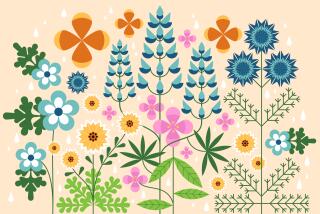IN THE GARDEN : Time to Plant for Winter Flowers
- Share via
It’s hard to believe that summer is going to let us off the hook so easily--that it’s almost over and has yet to get hot--but autumn is approaching and that signals a change that gardeners should take advantage of.
Sitting on my sister-in-law’s deck in Valencia last weekend, it didn’t seem like summer at all, even though it was the 27th of August. It was breezy and almost cool.
At the Arboretum in Arcadia, they are already talked about autumn as if it were here, even though the first day of fall is not until the 22nd of the month. And, those of us who live nearer the beach have hardly seen the sun all summer. It’s been two blankets at night and a sweat shirt in the morning all summer--one long June.
Lest we get too cocky and begin fall planting in earnest, remember that our worst heat often comes in September, but there are things to plant right now, that will survive a week of heat and flower in October or November, well ahead of the normal spring bloom.
If you want flowers in the garden during Thanksgiving and Christmas, you can, if you act soon. At the Arboretum in Arcadia, the “standard fare” for early-September planting, according to Director Francis Ching, includes calendulas, Iceland poppies, pansies and stock.
Wait in Inland Areas
They plant these from small packs or flats so these are little plants to begin with--no buds or flowers are showing--but they make strong growth in the warm weather and they usually have flowers in October and certainly by November.
Ching cautions that farther inland--in Pomona, San Bernardino or the San Fernando Valley--you should wait another two weeks to a month before doing any planting. Early October would be a better bet than early September.
Be sure to plant on a cool day, and check the forecast to see that it will stay cool for a day or two, because the first few days are critical, until the young plants put a few roots out into the surrounding soil. It’s also a good idea to plant at the end of the day rather than in the morning, so plants have the cool of the night to adjust to the shock of moving to a new home.
And be sure to water each plant before and after planting. This is perhaps best done with a long watering “wand” so you can individually soak each plant. This makes sure that the root ball is wet, not just the surrounding soil, and it helps conserve water because you are not sprinkling the entire bed, which at this point is mostly bare ground.
It also helps keep weeds from germinating in the empty soil between the new plants, and with the approach of autumn comes a whole new crop of weeds.
There is an “element of risk,” Ching says, and you may lose a few plants if it gets real hot for more than a few days. Near the coast, you are a little safer, but Susan Brozowski, the color specialist at Sherman Gardens in Corona del Mar, suggest the same sure-fire plants for early September planting--calendulas, Iceland poppies, pansies and stock.
Because Sherman Gardens is a small public garden, they plant these from 4-inch or quart pots that already have buds or flowers, for a more instant effect. They also tend to wait a little longer, hoping to miss that hot week so typical early in the month. The larger plants are more vulnerable to heat than the smaller plants from packs.
They also plant chrysanthemums this way--in flower in 4-inch pots--not the big cut flower kinds, but the smaller bedding types. This gives them color through September and October and then these are replaced by other winter flowers, such as English primroses in early November, so there is one other option for fall color.
Planting from 4-inch pots can get pretty expensive, but they are the perfect candidates to fill larger containers sitting on patios or balconies.
One more flower that should be planted right away is the old-fashioned sweet pea, but these should not be started from small plants, but from seed. The best sweet peas are grown from seed and are the tall vining types, so be prepared give them something to scramble up.
The seed can be planted as close as an inch apart along a wall or fence because the plants are not wide, but they are tall and can easily climb to the top of a 10-foot trellis by spring. If you don’t have a suitable place out in the garden, consider planting them in pots.
Last fall, I tried this for the first time and it was a great success. I put about a half-dozen seeds in pots a little larger than a foot across, filled with commercial potting soil. Canes cut from a clump of bamboo were the supports, and at 8-feet-long, were just tall enough. The sweet peas bloomed for a good two months and there were enough for cutting.
If you want to try some of the extremely fragrant old-fashioned varieties, write to the County Garden, Route 2, Box 455A, Crivitz, Wis. 54114. They specialize in seeds for cutting garden flowers and offer many strains of sweet pea plus an “old-fashioned scented mix.” Their catalogue (mostly of unusual cut flowers but also perennials) costs $1.






